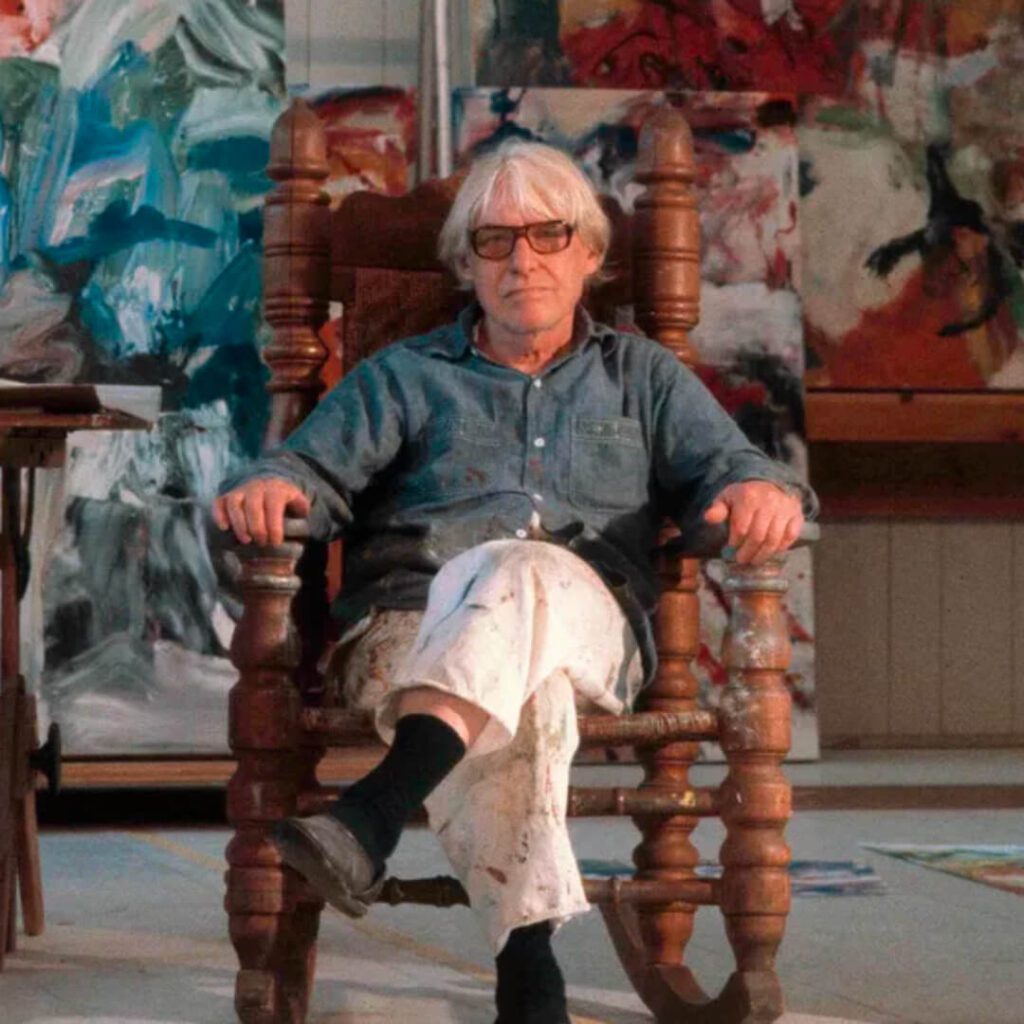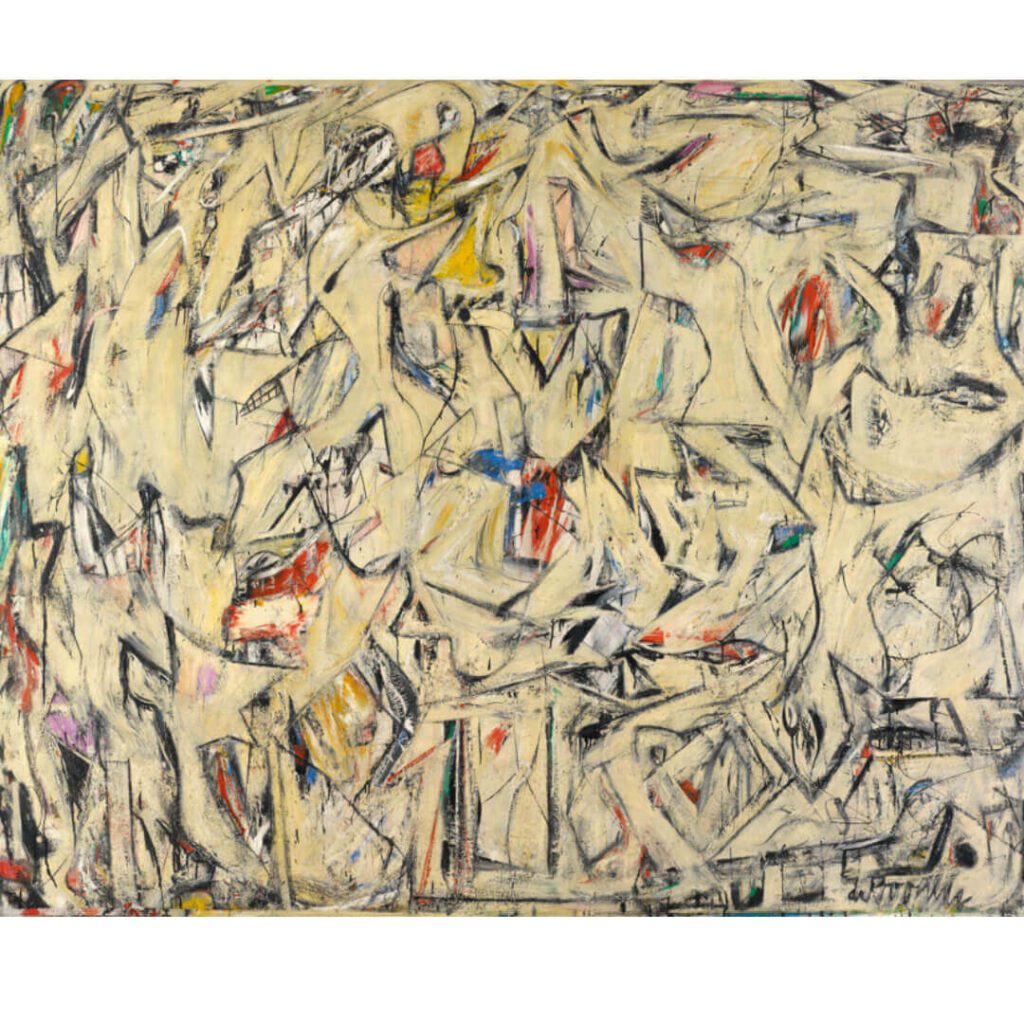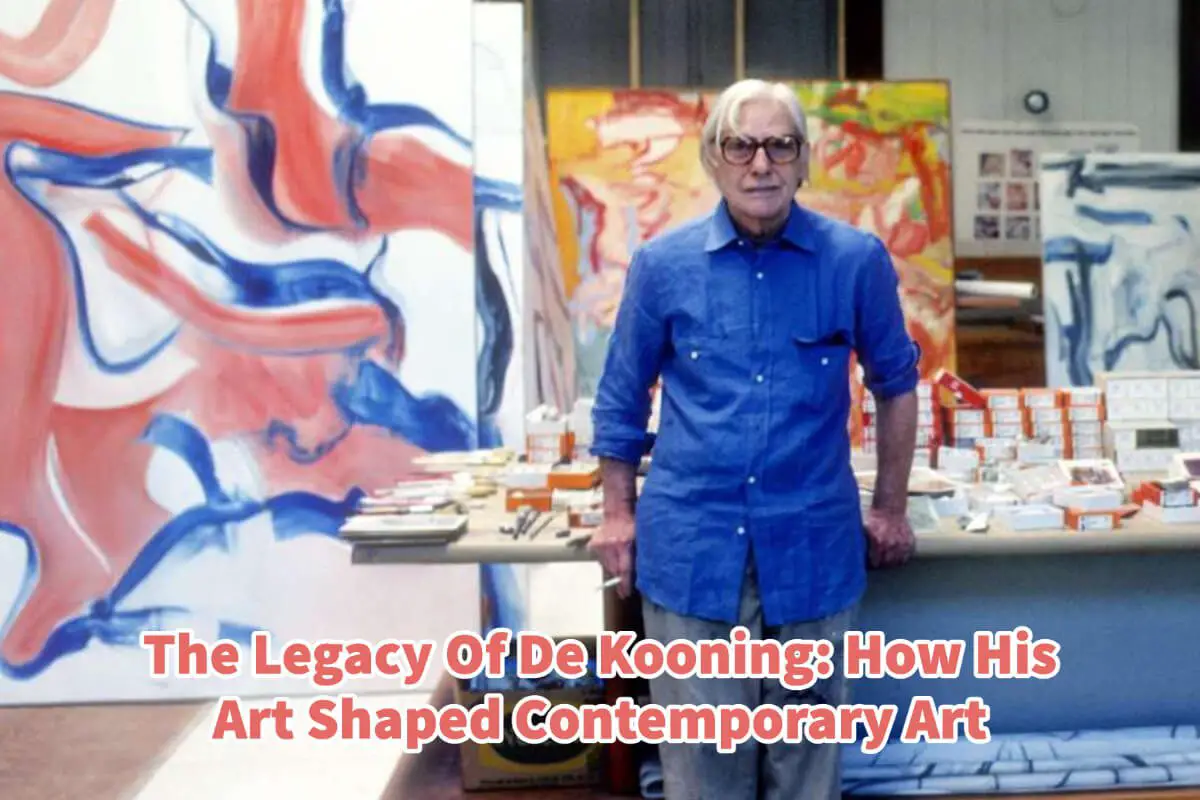One of my favorite Abstract Expressionism artists is Willem de Kooning. Willem de Kooning has some great artwork and deserves his artistic legacy.
Willem De Kooning was a Dutch-American painter widely considered one of the most influential artists of the 20th century. He was a leading figure in the Abstract Expressionist movement, and his work continues to influence contemporary art today. Read on as we explore De Kooning’s legacy and how his art shaped contemporary art.
Table of Contents
- De Kooning’s Importance As An Artist
- Willem De Kooning’s Legacy Explored
- Willem De Kooning Established The Abstract Expressionism Movement
- De Kooning Uses Bold, Gestural Brushstrokes And Colors
- De Kooning Influenced Pop Art
- De Kooning Experimented With Materials
- De Kooning Was Innovative
- De Kooning Helped Establish America As A Major Center Of Art
- De Kooning Challenged Traditional Artistic Notions
- Abstract Expressionism Was An Important Art Movement
- Frequently Asked Questions
- Related Questions
De Kooning’s Importance As An Artist
De Kooning’s importance as an artist stems from his ability to break down barriers and redefine what art could be. De Kooning was not content to continue in the traditions of the past but was constantly looking for new ways to express himself through his art.

De Kooning was particularly interested in exploring the relationship between abstraction and figuration, and his work often blurred the boundaries between the two.
Willem De Kooning’s Legacy Explored
De Kooning’s legacy can be seen from his influence on the artists who came after him to about how his ideas about art remain relevant today.

Read on as we explore ten ways in which his artwork and style changed contemporary art and artists:
Willem De Kooning Established The Abstract Expressionism Movement
De Kooning helped to establish Abstract Expressionism as a significant art movement in the United States. His work, along with that of other Abstract Expressionists like Jackson Pollock, Mark Rothko, and Franz Kline, helped to redefine what art could be in the post-war era.
De Kooning Uses Bold, Gestural Brushstrokes And Colors
De Kooning’s use of bold, gestural brushstrokes and vibrant colors was a departure from the more traditional styles of painting that had come before. His work helped to establish a new vocabulary for artists, one that was more expressive and less concerned with strict representational accuracy.
De Kooning Influenced Pop Art
De Kooning’s exploration of the human figure and its fragmentation significantly influenced the development of Pop Art in the 1960s. Pop artists like Roy Lichtenstein and Andy Warhol took the idea of fragmentation and used it to comment on the mass-produced, commercialized world around them.
De Kooning Experimented With Materials
De Kooning’s willingness to experiment with different materials, such as household paints and found objects, helped break the boundaries between art and everyday life.
De Kooning Was Innovative
De Kooning’s use of light and shadow and his innovative composition impacted contemporary artists. Many artists today continue to experiment with these elements, building upon the foundation laid by De Kooning and his contemporaries.
De Kooning Helped Establish America As A Major Center Of Art
De Kooning’s work helped to establish the United States as a major center of contemporary art in the post-World War II war era. Artists worldwide came to the United States to be a part of the burgeoning art scene, which helped establish New York as a global hub for contemporary art.
De Kooning Challenged Traditional Artistic Notions
De Kooning’s work challenged traditional notions of beauty and femininity. His use of the female figure as a subject was controversial, but it helped to establish the idea that art could be a vehicle for social and political commentary.
De Kooning’s influence on contemporary art can be seen in the work of artists like Gerhard Richter, who shares his interest in the relationship between abstraction and figuration.
De Kooning’s legacy is also evident in the continued importance of painting as an art form. Despite the rise of new media in contemporary art, painting remains a vital and relevant medium, thanks in part to the innovations of De Kooning and other Abstract Expressionists.

De Kooning’s legacy is a testament to the power of art to shape culture and society. His work challenged the status quo and helped to establish a new way of thinking about art and its role in the world.
Willem De Kooning’s legacy is a testament to his importance as an artist and lasting impact on contemporary art. De Kooning challenged traditional notions of art and established new ways of thinking about painting, and the human figure helped to shape the art of the post-war era and beyond.

De Kooning’s influence can be seen in the work of countless artists who have followed in his footsteps, and his legacy continues to inspire and inform contemporary art today. From his use of bold, gestural brushstrokes and vibrant colors to his willingness to experiment with different materials and explore new ideas,
De Kooning’s art has profoundly impacted contemporary art and artists. His legacy is a testament to the power of art to shape culture and society and to the enduring importance of artists willing to push the boundaries of what art can be.
Abstract Expressionism Was An Important Art Movement
Abstract Expressionism was a vital art movement that emerged in the United States in the years immediately following World War II. It was characterized by a focus on the spontaneous, gestural qualities of painting and an interest in abstraction and non-representational forms.

Willem De Kooning was one of the founders of the Abstract Expressionism movement, and his work played a significant role in its development and success.
De Kooning was drawn to the principles of Abstract Expressionism because they allowed him to explore new ways of expressing himself through his art. He was interested in art as a form of spontaneous expression and saw painting as a way of tapping into the deeper, more intuitive parts of himself.
This focus on spontaneity and intuition was a hallmark of Abstract Expressionism, and it helped to distinguish it from other art movements of the time.
Willem De Kooning and other Abstract Expressionism artists were important because they provided a way of breaking down the barriers between art and everyday life. In the post World War II war era, there was a growing sense that traditional art forms, such as painting and sculpture, were becoming increasingly irrelevant.
Abstract Expressionism offered a new way of thinking about art, one that was more expressive and less concerned with the strict representation of the visible world.
Another important aspect of Abstract Expressionism was its emphasis on individuality and personal expression. For De Kooning and other artists, this was a liberating idea that allowed them to explore new ways of thinking about their own identity and their place in the world. By rejecting the conventions of traditional art, they could forge a new path, one that was uniquely their own.
Abstract Expressionism was important because it established the United States as a major center of contemporary art in the post World War II war era. The movement attracted artists worldwide and helped establish New York as a global hub for contemporary art. This legacy continues today, with New York remaining one of the world’s most important centers of contemporary art.
Abstract Expressionism was a vital art movement. The movement emphasized spontaneity, individuality, and personal expression, and provided a new way of thinking about art that continues influencing contemporary artists today.
The legacy of Abstract Expressionism can be seen in the continued importance of abstract painting as an art form and the enduring relevance of artists like De Kooning,
Willem De Kooning pushed the boundaries of what art could be; he helped show us all that art knows no boundaries.
Frequently Asked Questions
Who is Willem de Kooning, and what makes him a significant figure in the art world?
Willem de Kooning was a Dutch-American Abstract Expressionist painter known for his influential contributions to 20th-century art. His unique style and innovative techniques played a crucial role in shaping the art world during his time and continue to impact contemporary art.
What are some key characteristics of Willem de Kooning’s artwork?
De Kooning’s art is characterized by dynamic brushwork, gestural abstraction, and a fusion of figurative and abstract elements. His paintings often explore the tension between chaos and order, creating a sense of movement and emotion.
How did Willem de Kooning contribute to the Abstract Expressionist movement?
De Kooning was a central figure in the Abstract Expressionist movement, which emphasized spontaneous, emotional expression through art. His bold experimentation with form and color pushed the boundaries of traditional painting and influenced the development of this influential artistic movement.
What role did Willem de Kooning play in shaping contemporary art?
De Kooning’s impact on contemporary art is profound. His explorations of abstraction, expression, and the relationship between form and content paved the way for subsequent generations of artists to challenge conventions and push artistic boundaries.
Can you highlight some of Willem de Kooning’s most famous artworks and their significance?
Notable works include “Woman I” and “Excavation.” “Woman I” is a powerful example of his exploration of the female form, while “Excavation” showcases his mastery of layered abstraction. Both pieces are celebrated for their innovation and influence.
How did Willem de Kooning’s immigrant background impact his artistic perspective?
De Kooning’s Dutch-American heritage influenced his unique perspective on art. His exposure to European and American artistic traditions allowed him to synthesize diverse influences, contributing to the richness and complexity of his work.
In what ways did Willem de Kooning’s art challenge traditional notions of representation?
De Kooning’s art often blurred the lines between representation and abstraction. His dynamic, expressive brushstrokes and fragmented figures challenged conventional ideas about how art should depict the world, opening up new possibilities for artistic expression.
How did Willem de Kooning’s personal life impact his artistic journey?
De Kooning’s personal life, marked by struggles with alcoholism and relationships, is reflected in the emotional intensity of his art. The complexities of his experiences added depth to his work, making it a rich tapestry of personal and artistic exploration.
What is the lasting influence of Willem de Kooning on contemporary artists and art movements?
De Kooning’s influence is evident in the work of countless contemporary artists. His emphasis on individual expression, experimentation, and breaking free from artistic constraints continues to resonate with those pushing the boundaries of art today.
How can enthusiasts and aspiring artists engage with the legacy of Willem de Kooning?
To appreciate and engage with De Kooning’s legacy, enthusiasts can visit museums and galleries featuring his work, read about his life and artistic philosophy, and explore their own creativity through experimentation with abstraction and expressive techniques inspired by his innovative approach.
Anita Louise Art is dedicated to art education, great artists, and inspiring others to find and create their art. We love art that uplifts and inspires. #ArtToMakeYouSmile! #ArtToMakeYouHappy!
If you are interested to see any of my art, you can find out more by clicking here. If you are interested in what inspires me and my paintings, you can discover more by clicking here.
We have a free newsletter and would love you to be part of our community; you can subscribe to the newsletter by clicking here. I would be happy to talk to you if you have any questions. You can reach me, Anita, by clicking here.
Subscribe to our Anita Louise Art YouTube Channel with great videos and information by clicking here.
Join us for our podcast “5 Minutes With Art.” Spend just 5 minutes a week with us to discover and learn about great art and artists. You can find out more about our podcast by clicking here.
Related Questions
Why Are Mark Rothko’s Paintings Considered Special?
Mark Rothko’s paintings are remarkable because they are original works of art. He is one of the founders of the abstract expressionism movement and color field painting. But more than that, he believed that his spirit lives within the art and that we, the individuals, ca we view his art, can be taken to a different realm.
By clicking here, you can learn more by reading Why Are Mark Rothko’s Paintings Considered Special?.
Who is the American Artist Jackson Pollock (1912-1956)?
Jackson Pollock is considered by some to be one of the most brilliant American abstract artists that ever lived. Others consider his work of art as tossing around cans of paint by an artistic madman. One thing for certain is that Jackson Pollock is an important American abstract artist.
You can learn more by reading the blog Who is the American Artist Jackson Pollock (1912-1956)? by clicking here.
Who Was The Western American Artist Minerva Teichert (1888-1976)?
Minerva Teichert was, by all accounts, a cowgirl from Idaho who loved art. She studied art in both Chicago and New York. Minerva is known for her artwork of daily life in the western United States, historical events, and scenes from the scriptures.
You can read more by reading our blog Who Was The Western American Artist Minerva Teichert (1888-1976)? by clicking here.

